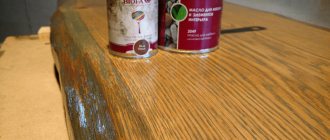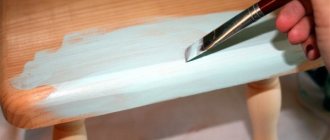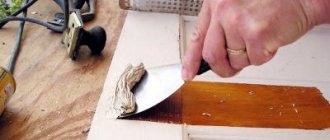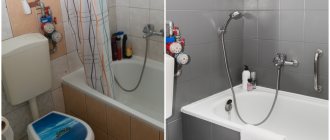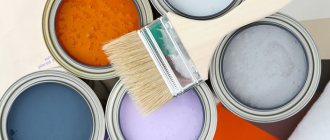Acrylic compounds are used very often. Due to their water-repellent properties and resistance to light, this paint and varnish material is used for processing furniture, protecting car bodies, and applied to artwork and household items. It is important to decide whether or not painted structures and products need to be treated with varnish? Experts say that it is necessary to varnish, thanks to this the service life of acrylic paint is extended and the material remains attractive for a long time. For this purpose, a special varnish for acrylic paints is used, which has many advantages.
Acrylic varnish is made from several components, including a polymer material, a plasticizer and a plastic dispersion, which creates a strong and durable protective layer that protects the treated base from the harmful and aggressive influence of the external environment and mechanical stress. To understand which is best to use varnish with acrylic elements, you need to consider what types of these compositions there are.
Varieties
Stores today sell various types of acrylic compounds and other mixtures. Here is a list of the most common and effective varieties:
- water-based solutions. Their main purpose is wood processing. These mixtures are fire-resistant, colorless, and reliably cover and protect the material. Their disadvantage is low resistance to sudden temperature changes. With rapid changes in air temperature, the surface treated with such acrylic varnish may begin to crack and crumble;
- oil compositions. They are made on a synthetic or organic basis, and have the appearance of an oil or resin. They fit well on wood, are perfectly absorbed into it, and extend the service life of the structure. These varnishes harden quickly, but the complete drying process takes several days;
- nitro varnishes. These mixtures instantly interact with the treated surface and air, so they dry very quickly. It is important to remember that they are highly toxic solutions, so when working with them you must wear a respirator and properly ventilate the room. First you need to try how this solution will behave on a small area of the treated base;
- alkyd mixtures. They are made from resin and synthetic solvent, have an average drying speed and sufficient resistance to moisture. They are universal, very easy and quick to apply with conventional tools. For application you can use a spray bottle, brush or roller. Alkyd solutions can be treated both indoors and outdoors; they are used to protect building facades, because they are not afraid of sudden temperature changes;
- polyurethane paint and varnish products. They are used in many areas because they are well compatible with any type of base and paint. Polyurethane varnish solutions are not afraid of the harmful effects of the external environment. One of the disadvantages is the relatively high cost and complexity of application;
- epoxy varnish mixtures. Most often they are used in rooms where there is often a high level of humidity, this includes saunas, wooden baths, and swimming pools. The epoxy solution dries quickly and is not afraid of mechanical stress.
When choosing one or another varnish composition, you need to remember that they are sold not only transparent, but can have any shade and shine - glossy, matte or pearlescent.
Techniques for high-quality varnishing
The varnish is applied in two or three steps (with intermediate drying) in any convenient way: with a brush, sponge, spray gun. To ensure a high-quality result, you need to remember the following nuances:
- The surface coated with acrylic paint must dry completely. Depending on the thickness, the process can take from three days to two weeks (full strength gain takes 30 days).
- When choosing a varnish mixture, the quality of the surface is taken into account. Irregularities are more noticeable under the gloss, while the matte layer hides them.
- Pre-priming the surface will reduce varnish consumption. A water-based primer will do.
- Acrylic varnish is diluted only with water (preferably distilled), and water by volume should not exceed 10% of the composition itself.
The primer will help save varnish consumption Source gidpokraske.ru
Main properties and advantages of acrylic
Acrylic varnish has many advantages compared to other varnish solutions, because acrylic has excellent quality and properties. The acrylic composition combines elasticity with high strength, quickly and reliably adheres to the base, thereby guaranteeing a long service life. A structure or product treated with an acrylic composition is not afraid of external influences, including mechanical damage, high humidity, frost, and sunlight.
When acrylic varnish is applied inside a residential building, protection against the appearance of fungi and mold is guaranteed, in addition, acrylic varnish is fireproof. It can be applied to plastered walls, brickwork and wood surfaces and creates an equally durable protective layer on them. Here is a list of the main properties of acrylic compositions:
- practically no smell;
- good interaction with acrylic paint and water-soluble paints and varnishes;
- minimum drying period;
- high strength of the layer that protects the surface from the external environment;
- rapid solubility in liquids containing water;
- sufficient ductility;
- high rate of adhesion or adhesion to different types of surfaces and materials;
- resistance to water;
- maintaining absolute transparency, even after prolonged exposure to ultraviolet rays.
Many people are interested in what varnish to coat acrylic paints with? Acrylic varnish is an ideal option for this type of paint; in addition, a polyurethane varnish composition is suitable.
Among the advantages of varnish with acrylic elements are the following:
- resistance to different temperatures;
- resistance to moisture, good thermal conductivity;
- resistance to mechanical stress;
- small weight;
- high strength and elasticity;
- environmentally friendly and safe, can be used for interior work in residential premises;
- protecting the surface from the appearance of microorganisms, including mold and fungi;
- aesthetics, external attractiveness;
- versatility of use, acrylic varnish can be applied not only to wood, but also to putty, plaster and brick walls.
Why varnish products
Many types of needlework suggest coating the product with varnish at the final stage of production. The importance of this procedure is difficult to overestimate. Varnishing performs a number of important functions:
- Gives the work a finished look. Moreover, varnish coating can hide defects and flaws made during the work process.
- Protects the surface from the adverse effects of environmental factors (temperature changes, humidity, dust, dirt, etc.). The varnished surface is more resistant to scratches, fading in the sun or swelling due to moisture. The protective film that the varnish forms prevents the material from deteriorating.
- Has a decorative effect. Modern varnishes can not only emphasize the brightness of colors and give a noble shine to your painting, box, figurine or any other product, but can also have various decorative properties - an aging effect, contain glitter or make the surface velvety to the touch. If we are talking about painting, then varnish emphasizes the small details of the drawing, making the picture more voluminous.
Areas of use of acrylic varnishes
Since these compounds are universal and unique in their properties, they are very often used during construction, repair, and finishing work, sometimes even used instead of enamel or paint. When asked what varnish to coat acrylic paint on wood with, experts give a clear answer - an acrylic-based varnish solution. But in addition to wood, which the composition protects from pests, damage and moisture, this type of varnish product is used for:
- processing of products and structures in the construction industry. In addition to acrylic paint, the solution is used for many other materials;
- protection of all kinds of interior elements. Can be used to cover furniture, wooden railings, stairs, baseboards, windows, doors, and others;
- They produce special varieties for covering yachts. This product has increased resistance to temperature changes and high humidity;
- production of various adhesives and construction and finishing mixtures.
General information
The first thing that interests home craftsmen when they are faced with a similar task is whether it is possible to paint with paint over varnish? Of course, it is best to remove the old coating, but if this is not possible, or you need to save time, then you can paint over the old coating.
True, in order to say with confidence whether it is possible to apply paint to varnish, it is necessary to clarify what kind of paint and varnish material we are talking about. The fact is that not all compositions are suitable for these purposes. For example, you cannot use nitro paint, as the old coating will begin to peel off over time.
In addition, before applying the coloring composition, the surface still needs to be prepared in a certain way.
Rules for choosing varnish and varnish
So, it’s clear whether acrylic paint needs to be varnished, it’s definitely necessary. Now it is important to determine whether the chosen varnish is suitable for the existing base and paint. The base can be wood, plaster, putty or acrylic paint. It is necessary to choose a varnish mixture that is as fresh as possible; it is advisable that no 3 months have passed since its manufacture.
It is better to give preference to a matte surface rather than a glossy one, since acrylic paint applied to wood or putty does not need a shiny surface.
After choosing a varnish solution for paint, you need to start cleaning the surface. You can only varnish a clean base, free from dust, dirt, greasy stains and flaking areas. If varnish is applied to paint, it must adhere firmly and securely to the base. Before applying the varnish composition, it must be heated to 50 degrees, preferably in a water bath. A three-liter container of varnish is usually heated for 5 minutes; during heating, the mixture must be stirred all the time.
After heating, you can begin to varnish the paint or other base. If application is done with a brush, it is important to ensure that the mixture does not drip from it. It is advisable to cover the base in small areas. When one area begins to harden, you need to start varnishing the next area.
Varnishing the base is quite difficult, because the mixture on wood or paint hardens quite quickly, and if dust gets on the varnish, then all the work will be done in vain. At first, it is advisable to practice a little on an inconspicuous small area, and when it starts to work out well, you can move on to the main surface. When approximately half a square meter has been processed, it is necessary to polish the applied coating. Polishing is done with a dry brush, and when it begins to stick to the base, you can begin varnishing the next area.
How to prepare the surface
It is important to choose a varnish for the task at hand, taking into account the operating conditions. You also need to know that the matte type helps cover minor imperfections. Acrylic paint is glossy, so matte finishes can be used on top. If the varnish is glossy, then an even base without the smallest scratches will be required so that the layer looks smooth and beautiful.
It is advisable to use new varnishes, after production, which have passed no more than 3 months. There are formulations in cans; they are chosen for processing small wooden products and are easy to use.
If you choose a standard type of varnish rather than an aerosol, you will need to select a tool for application. Brushes with hard bristles or synthetic material are better suited. Flute brushes work well for large areas.
After preparing the tools and materials, the following steps are required to prepare the base:
- It is important to wait until the paint layer has completely dried, only then can you proceed to varnishing.
- The varnish is applied to a surface that is free of dust and other contaminants; it may be necessary to degrease the base.
- It is recommended to apply the primer solution to the entire surface; an acrylic type of primer mixture is used; also wait until the layer is completely dry before moving on to the next step. A layer of primer helps improve adhesion and prevent cracks on the surface.
- The room should have a good level of light, the direction of the light should be from the right side, from above the base, then you can notice the areas that remain unvarnished.
It is important to wait until the paint layer has completely dried, only then can you proceed to varnishing.
Important Tips
- Before varnishing the surface, it is advisable to prime the base if paint has not already been applied to it. Tinted impregnation or a water mixture is used as a primer.
- To ensure that the base, such as wood, is mirror-like and as shiny as possible, each layer of varnish, in addition to the last, is treated with fine sandpaper.
- To prevent defects and unevenness from being too visible on the paint and varnished product, it is necessary to choose not a glossy, but a matte composition, which conceals all errors.
- To dilute the acrylic-based varnish solution, you can only use clean water; its volume should not be more than 10 parts. Dilution with solvent, other type of varnish or drying oil is not allowed.
- You cannot apply a varnish composition to wood or paint if the air humidity is very low, less than 50%, because the mixture will dry out very quickly and defects will appear on the base.
- Varnishing of greasy substrates is not allowed. First, they are treated with a soap solution, after which they need to be dried.
- To ensure an even coating of varnish applied to the paint, it is necessary to apply the mixture in several thin layers, this is much better than applying one thick coat.
- To ensure uniform varnishing, the old varnish coating is first cleaned, or a dark varnish is used.
Which varnish composition is better to choose?
Acrylic varnish, which is fully compatible with the coloring composition, is more expensive than synthetic analogues. It is used if the appearance of the item has special significance, for example, a painting or a piece of furniture made for sale. If staying within your budget is important to you, you should stick with regular wood varnish. Before purchasing, you should study the label to find out the following points:
- Will the coating protect against moisture?
- Will the varnish layer be UV resistant and how quickly will it dry completely?
- The composition is permanent or removable.
- Is the varnish elastic or hard? Stretch film is suitable for flexible substrate (wood or canvas) that changes dimensions; it will not form cracks due to changes in temperature and humidity. Hard varnish is used if acrylic is applied to a hard wooden surface.
After drying, the varnish coating becomes transparent Source vitospb.ru
What options does the range of compatible paint materials offer?
Environmentally friendly water-dispersed silicone-based paints meet all the requirements for strength, resistance to external influences and durability that apply to high-quality protective and decorative coatings.- Environmentally friendly silicone materials are produced in a wide range of colors.
- Having good adhesion to any substrate and excellent light resistance, the silicone coating is applied without drips or streaks, dries quickly, and can be used outdoors without any problems.
- Very weather-resistant alkyd enamels are characterized by a bright, rich color, are easy to work with, and can be used for exterior and interior use.
- The cost of alkyd enamels is lower than silicone paint, but when applying it, it is recommended to install temporary exhaust ventilation and use protective masks or respirators.
- The characteristic odor of the solvent can be felt indoors for several days. And therefore, upon completion of work, it is advisable to ventilate the house more often. In the best case, it is better to postpone the decor update to the warm season.
Standard paint consumption
| Paint type | Paint consumption m2/l | Number of layers | Drying time |
| Water-based | 0,15-0,2 | 1 | 2-3 hours |
| Acrylic | 0,2-0,25 | 2 | 2-3 hours |
| Texture | 0,3-0,5 | 1-2 | 24 hours |
| Cement based | 0,5-0,9 | 1-2 | 24 hours |
We will help you choose and buy building materials correctly, and a team of true professionals will provide construction services in the shortest possible time and at an affordable cost!
Friends, we are very glad that acrylic paint is so popular among amateurs and professionals of needlework and expressive art. We receive a lot of interesting and unexpected questions about using acrylic paint. We answer the most common of them.
Stages of painting a wooden base
Note!
A primer will help improve the adhesion of paint to the varnish base - this is the name of a special primer that is applied to the wood in two layers. For varnish coating, a one-time treatment will be sufficient. There are many types of primer, so look for a solution recommended by the paint manufacturer.
- Apply the first layer of paint of the main shade. Most often, lacquered furniture has a deep brown color, so the base layer, through which dark wood is visible, should be light.
After the first layer has dried, apply the next layer of the main color.
Next, we paint the furniture facades with a contrasting shade. In this case it will be coral.
After the paint has dried, the entire surface along the borders is sealed with special masking tape. The borders are spray painted with a different shade.
The corners are sealed with overlapping masking tape, which is best cut into the required fragments with scissors.
Now you can paint the borders with spray paint and remove the tape.
The handles and key to the cabinets are painted gold to match the borders.
Features of tinting silicone paint
By thoroughly mixing, bring the paint into working condition. If a silicone dye is chosen as a consumable material, its composition can be tinted by adding colored pigments. To eliminate possible errors, select colors and dosage of dye in a small volume.
After receiving a positive result, tint the main volume in compliance with the proper proportions. Thin paint only with compatible thinner. The quality of the coating largely depends on the uniformity of the paint composition. You will save working time if you use a mixer or attachment on a household drill to mix the mixture.
